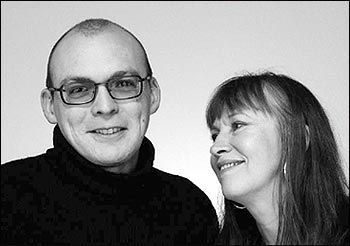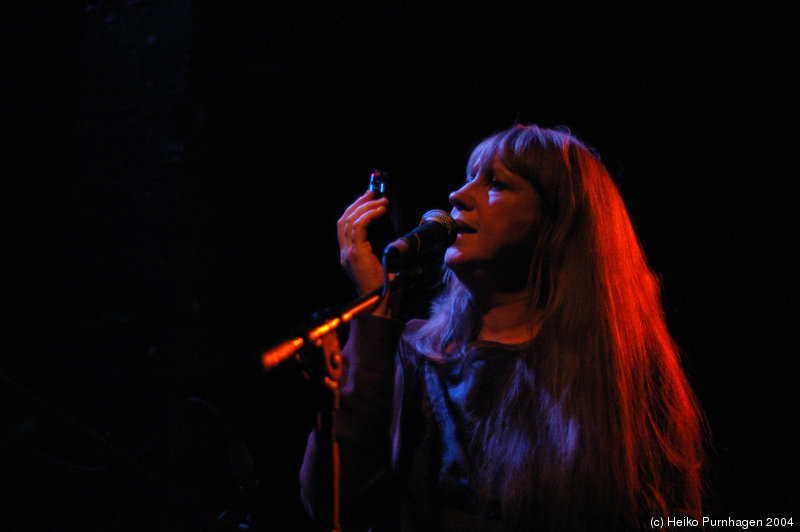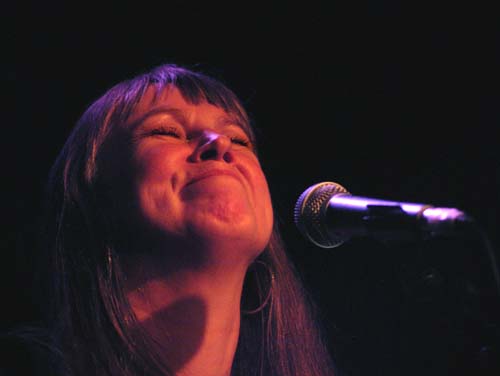SIDSEL ENDRESEN & BUGGE WESSELTOFT / “Try”
On the cover of Sidsel Endresen and Bugge Wesseltoft’s 2002 CD Out Here. In There. there is a photo of a snow-covered landscape. Apropos given that Bugge’s specialty is creating atmospheric ‘soundscapes.’ Truthfully, Bugge dabbles in a bit of everything—straight-ahead jazz, fusion, world music (I hate that phrase), electronica, etc. Essentially though, all of my favorite Bugge tunes sound the same. Not exactly the same, of course, more like variations on a theme…sort of like the Baldwin brothers’ faces. If enough time passes between sightings, you’re liable to think they’re identical. See them side-by-side and…OK, I’ve been spending too much time in Santa Monica. And I’ve gotten myself way off topic. Let’s go straight into the songs.

I first heard “Try” a couple of years ago on L.A.’s famed indie station, KCRW. I liked it immediately. Bugge’s music had that graceful, effortless feel that I gravitate towards. It was also beautifully minimalist: nothing but Bugge picking out a chord here and there on his keyboard backed by the muffled thump of electronic drums. But it was Sidsel’s voice that really caught my attention. Sidsel’s vocal range is limited—no one’s ever going to mistake her for an Aretha Franklin or a Chaka Khan…or even a Mariah Carey, for that matter. But her sound! The tone she coaxes out of her vocal chords reminds me of the rich, sweet sound of an old-time clarinet player. Sidsel is also a lyricist of considerable skill. Often, her writing has both the economy and the emotional impact of poetry. A couple years after I first heard “Try,” it turned up in the movie Prime. Hopefully, that turned a few more people on to Bugge and Sidsel.
Kalamu introduced me to another Bugge and Sidsel duet, a dead-ringer for “Try” named “You Might Say,” and since then, “You Might Say” has become one of my favorite songs. The structure of the lyrics is perfect. Sidsel makes a list of all the things her man “might say” (or, at least, what the woman in the song’s man might say) when things have gotten bad.
You might say…“But I say,” Sidsel sings. And you’re sitting there waiting, thinking, “What can she possibly say? He said it’s over.” The first time around, Sidsel leaves it hanging, “But I say….” Then she goes back to the list. The second time, she finishes the sentence. “‘Please.’” That’s it. Just ‘please.’ Man, oh man.
You need me no more
We’ve been here before
We’ve got no place to go
The well has run dry
We’re living a lie
You don’t want to try
It’s over

The brilliant thing about Sidsel’s performance is the way she uses her vocal limitations to her advantage. When she sings ‘please’ she reaches for a high note that’s just out of her range. When her voices starts to break, you feel your heart breaking right along with her. If she were a ‘better’ singer, she would’ve nailed the note perfectly and you might wonder to yourself whether or not ol’ boy is gonna change is mind. As it is, you know he won’t.
Here’s a couple more Bugge tracks for you. The first, something called “eL.,” sounds just like “Try” and “You Might Think” except it’s all instrumental. Bugge’s piano and Joshua Redman’s saxophone take the place of Sidsel’s voice. The last tune is “SKoG.” It’s a lot like “eL.,” except faster, and when Joshua is supposed to come in, a Norwegian folk singer by the name of Øyonn Groven Myhren comes in instead. Listen to Bugge’s music late at night and it sounds like one long pretty song.
—Mtume ya Salaam
Northern Soul
Mtume, here we have one of the beautiful paradoxes of Black music, which, as we both know, consists of specific genres created out of specific cultural contexts. As these folk so ably demonstrate, anybody can learn the basics, add their own ingredients, and thereby produce genuine Black music that simultaneously retains its root elements while reflecting culturally-grafted elements.
Jazz is the common denominator here, which implies elevation of improvisation as composition (generally with a strong rhythmic base). For all its African antecedents, jazz is centrally located in the industrial Western experience. Most of the basic instruments of jazz are machines: the drum kit (levers, pulleys, nuts and bolts, wood and skin combined with metal), damn near all the horns (metal with levers), the piano (a mainly wood machine augmented by metal worked by levers).
What is hip about jazz is that when the music is really happening, you don’t think one bit about machines, what you hear and identify is the human element, the “voice” of the players; indeed, the best jazz musicians are easily identified by how they sound.
So we have these Norwegians taking jazz into the 21st century, which means the use of electronics, but nevertheless that distinctive element is still happening.
I’ve added three cuts to Mtume’s choices; two from the Sidsel and Bugge album and one from a live album by Bugge. Sidsel is an experimental singer in the Jeanne Lee mode—if you don’t know Jeanne Lee, then there is a whole area of Seventies jazz vocal work that represents the outer reaches of vocal work.

Listen to “Heartbeat,” a spooky re-creation and investigation of melodic palpitations. Sidsel nails the avant garde fracturing of melody into sound units that duel with the simple words. “Truth” is just what it says: an investigation of truth telling and what truth telling means.
Bugge’s concert recording of “Sharing” uses electronic techniques in a very organic manner. That opening drum section could not have been done without the electronic augmentation and manipulation of attacks, delays and echoes. When the vocal line comes in, the words catch us by surprise precisely because we have become so caught up in the thicket of acoustic/electronic rhythms, it never occurs to the first-time listener that this might be a song in the sense that there is a melodic narrative. To specifically situate “Sharing” in the jazz tradition, think Weather Report stripped down to a trio.
An additional element is self-determination. Bugge started his own label, records in his home. In this new century, Bugge uses digital technology and the jazz emphasis on independence, in precisely the same way as the first creators did at the turn of twentieth century.
Sidsel and Bugge are wonderful extensions of a hard fought and very important jazz tradition of using the latest technology to develop improvised compositions that reflect a social commitment to individual and collective self-determination.
I really like that both Sidsel and Bugge’s music are deeply rooted in the jazz tradition even as they strike out into new territory. Hopefully, everyone can appreciate, if not outright dig, these Northern Soul sounds.
—Kalamu ya Salaam
This entry was posted on Sunday, November 5th, 2006 at 12:41 am and is filed under Contemporary. You can follow any responses to this entry through the RSS 2.0 feed. You can leave a response, or trackback from your own site.
Leave a Reply
| top |